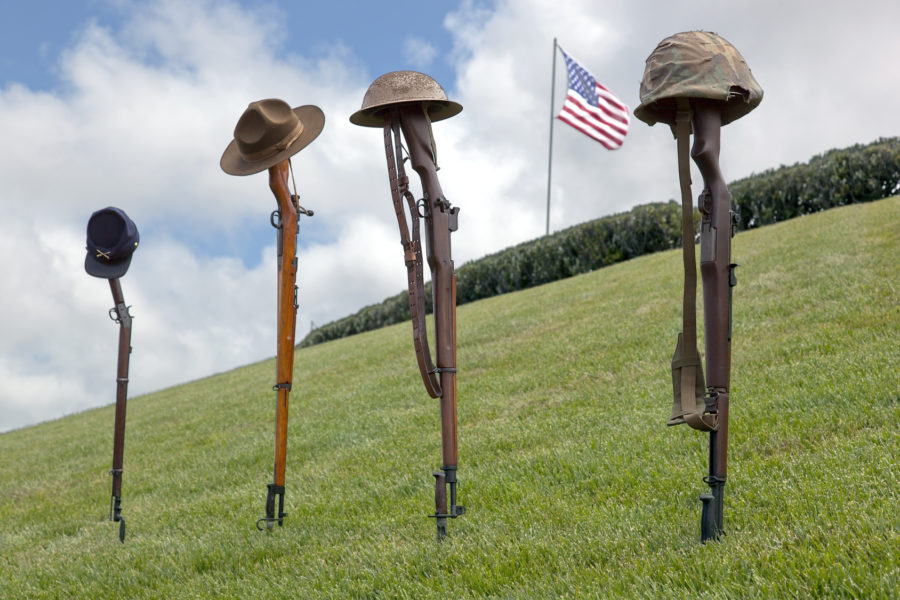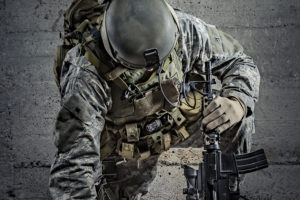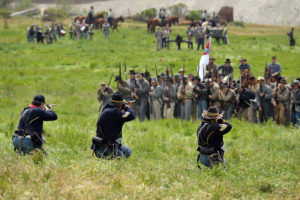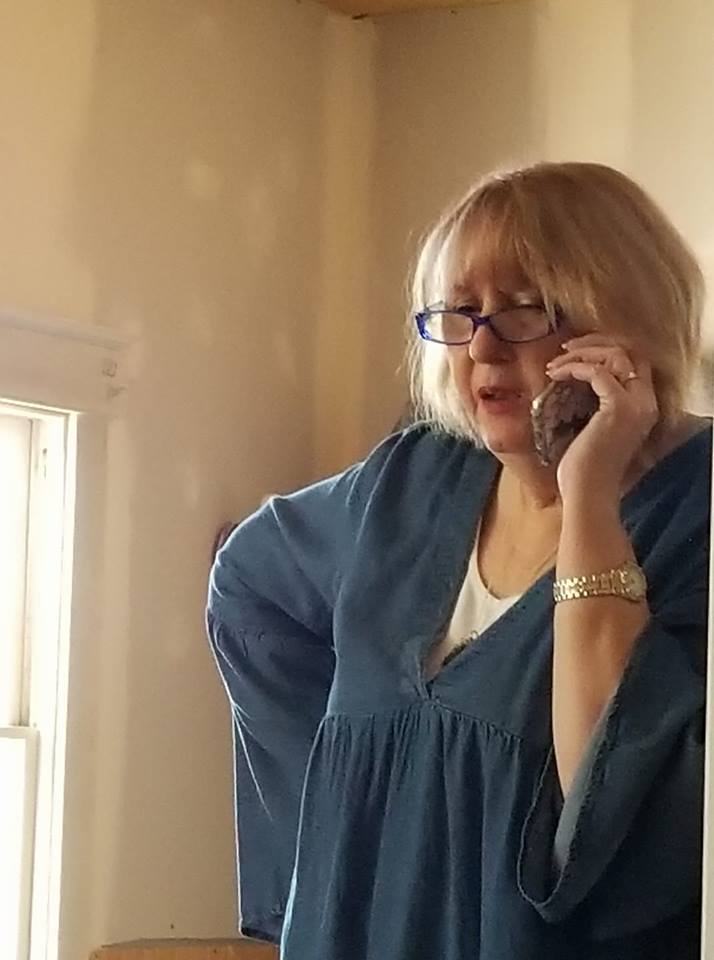During this Memorial Day, let us remember those who gave their all for freedom; gone but not forgotten.
By Rebecca Nidey
Everything I Need To Know I Learned In A Haunted House
I was born in 1954. That year is no more significant than any other. The end of World War II was still a raw wound that was just beginning to heal after it ended in 1945 with the loss of 405,399 lives. The Korean War had ended the year before I was born with a further loss of 36,516. While the nation was still in mourning, it was also taking a deep breath and learning to live again after the incredible destruction created during war.
Because of the forfeiture of so many lives, those that returned from the wars or had served stateside chose to commemorate by starting families. War is not only a battle against what is perceived to be a threat to our ideals, it is a means to protect from that threat those loved ones left behind who are gone but not forgotten. Raising and loving children is a way to both honor those who gave their lives in battle and express that there is still hope in the world…….and so I was born a member of the “baby boom” generation.
As a very young child, I can remember making an almost day long trip through this county and a few surrounding ones, visiting cemeteries to place flowers on the graves of family members. Since my neck of the woods is mostly rural, most of the graveyards were in the country. At the time, being very young, I only understood that it was a trip to a different world of silent, peaceful places with stones, most often much taller than me. As is with most children, I would help my parents place flowers on the graves till my attention span was exceeded. As long as I kept in sight, I was allowed to explore those stones. Since the cemeteries were most often surrounded by fields and small wooded areas I would spend time emulating my parents by picking small nosegays and laying them on the graves that caught my eye.
As I got older, I came to know this time as Decoration Day; now known as Memorial Day. As students, we were taught some of the meaning behind the holiday. However, it was not until I became much older that I understood the full price paid and commemorated by this special day. In my wanderings through the stones I would notice that many had small flags inserted by them. Some of the stones were actually a uniform, utilitarian style provided by the government in honor of their service. Often there were small plaques or insignias on or by the stones indicating they were members of organizations open only to veterans.
Although the United States had been to war before, the Civil War was the one that proved most divisive. Other wars pulled citizens together in a common cause. The Civil War literally tore families apart, pitting families and friends in mortal battle. Bad blood formed and was spilled, tearing apart the ties that bind. Over 625,000 lives were lost between 1861 and 1865. On May 5, 1868, the national commander of the Grand Army of the Republic, General John Logan, issued General Order No. 11. “The 30th of May, 1868, is designated for the purpose of strewing with flowers, or otherwise decorating the graves of comrades who died in defense of their country during the late rebellion, and whose bodies now lie in almost every city, village and hamlet churchyard in the land.” The date of the first Decoration Day was chosen because it did not represent the anniversary of any major battle and would not emphasize a win or loss to either side of the battle, but merely to honor those who were gone but not forgotten.
On that first Decoration Day, General James Garfield made a speech at Arlington National Cemetery. After the speech, the graves of the 20,000 Union and Confederate soldiers buried there were decorated. The fact that soldiers from both sides of the conflict were honored was significant, an attempt to bind together the states into a union again. However, the desired effect did not occur. By 1890, all Northern states had recognized the holiday but those in the South refused to do so; instead creating their own holidays to honor the fallen soldiers of the Confederate Army.
It took another war, World War I, to finally bring together the nation into a united front. Once again, the nation shared enemies that were not fellow Americans. In 1971, a National Holiday Act was passed by congress changing the name to Memorial Day and moving it permanently to the fourth Monday of May. Some Southern states still observe separate days of honor for the Confederate dead, but Memorial Day is the official day to commemorate and pay homage to all Americans who died fighting in any war.
To me, the ultimate way to honor all soldiers has been the burial place of those anonymous soldiers who served and died for the United States. While wandering local cemeteries, I have found many graves of soldiers of all conflicts. In at least one, I found a grouping of graves that showed a tradition of honor that was passed from generation to generation. Buried in close proximity were the veterans of the Revolutionary, Blackhawk, and Civil Wars… all bearing the same name. In at least one other graveyard I found a stone dedicated to “An Unknown Confederate Soldier.” That seems out of place for a county in Illinois until you realize that there was a prisoner of war camp as close as several counties away from Crawford County. Most likely, this anonymous Confederate soldier was on his way to that camp when he died of disease or his wound, only to be buried in a place far from home.
Doing research on the National Tomb of the Unknown Soldier, I stumbled on the site for the Society of the Honor Guard. This site explains the history of the Tomb and the warriors who provide the honor guard at the site. On March 4, 1921 Congress approved the burial of an unidentified American soldier from World War I. Eventually “unknowns” from World War II, the Korean War and the Vietnam War joined him. Each sarcophagus is the final resting place of the unidentified remains of a soldier from each of those conflicts except for the one erected for the Viet Nam War. At one time, it held a body, but those remains were exhumed on May 14, 1998. Through DNA testing the soldier who had lain there was identified and so, no longer could be considered an “unknown.” It was decided to allow that tomb to remain vacant but the cover was replaced with one that has the inscription “Honoring and Keeping Faith with American’s Missing Servicemen, 1958-1975”. The Honor Guard is on duty 365 days a year through all weather.
On this page dedicated to them I found an inscription that gave me goosebumps, “Soldiers Never Die Until They Are Forgotten. Tomb Guards Never Forget.”
Memorial Day is primarily a time to honor those who gave their lives in the ultimate sacrifice for their country. My family (and many others I know) chose to make it a time of remembrance of all those we had lost to death. To return to my childhood for a bit, one of the things I remember the most was the family history I was taught while accompanying my parents on our cemetery visits. While I was very young, the history was as simple as an explanation of who was buried in the graves and how they were related to me. As I got older, the stories went into more detail. I heard how some of the “residents” lived and died. Some of the sadder aspects could be told to me since I was more able to understand the fact that life is filled with both happy and sad occasions. In one graveyard, we decorated the graves of my paternal grandparents and one set of great grandparents. In between their stones was the tiny marker for a great uncle who died at an early age. He shared the same first name as my father who had been named after him.
As we drove from cemetery to cemetery, I was often taught other stories that gave me insight into the lives of those I love. I do not remember my paternal grandfather; he died when I was 9 months old. My father was always reluctant to discuss his death. My mother told me the story of the events of that day. Dad had been planting poppies in front of the house when word came of the unexpected death of his father. My Dad loved to garden, but because of the trauma he felt at the news of his father’s death, he refused to plant those particular flowers ever again. Through my younger years, I remembered a great uncle for his gentle nature and callused hands from years of farming. It was not until I was a young adult I heard the story of the death of his young son. My great uncle had accidentally backed his tractor over his child and the experience haunted him for the rest of his days.
In essence, I was being taught to remember. Life carries many memories of both joys and sorrows and all should be held in our memories and honored. By sharing the stories of those we care about, we are keeping them alive. They were gone but not forgotten. Even the flowers we used to decorate the graves were a legacy of remembrance of family. On either side of the front entrance of the home I live in currently (and have lived in all but 5 years of my life) are two rose bushes. The roses were started from bushes that were originally at the home of my paternal grandparents. These bushes are what are called heirloom roses with the name of Seven Sisters for the branches that can hold up to seven blooms per cluster. They have remained the same through many generations no matter how many times they were transplanted. It has always felt fitting that we chose to use them to honor those from our family.
Although we have a holiday that provides an opportunity to show homage to those who have passed before, do we really need to limit it to one day? This year, my family has celebrated the birth of my new great-nephew and great-niece and I am currently awaiting the arrival of another great-niece. It is my hope that I will be able to honor the memory of my parents and others in the family by sharing stories with them. If any of these young ones visit me and stop to smell those roses I mentioned I plan on sharing their history. Should any of them accompany me on a visit to a cemetery it would be my honor to tell them stories of those that rest in those graves. Remembrance should be an everyday occurrence. Maybe we should all become honor guards for those we have loved and lost. No one dies unless they are forgotten so we should be the honor guards that never forget.
I would like to leave you with one more quote that I thought was very apt.
“The whole earth is the tomb of heroic men and their story is not given only on stone over their clay but abides everywhere without visible symbol woven into the stuff of other men’s lives.” Pericles
About the Author:
 Through her work on the investigative team for the Crawford County Illinois Ghost Hunters, Rebecca Nidey has an understanding of the paranormal, spiritual, and metaphysical worlds and how they work together.
Through her work on the investigative team for the Crawford County Illinois Ghost Hunters, Rebecca Nidey has an understanding of the paranormal, spiritual, and metaphysical worlds and how they work together.
Rebecca has trained in the Healing Touch technique (a form of energy healing). She is a certified Psychic Medium trained by Belle Salisbury, and she is a certified Paranormal Researcher.
Rebecca is the associate editor for Bellesprit Magazine and also writes a column titled Everything I Need To Know I Learned In A Haunted House. She has been a co-host of several radio programs for the Haunted Voices Radio Network and HeyZ Radio Network highlighting the Paranormal, metaphysical and literary fields.
To learn more about Rebecca or to schedule a reading you can contact her at https://www.facebook.com/rebecca.nidey.





